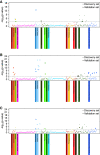Environment-Wide Association Study of CKD
- PMID: 32628126
- PMCID: PMC7274289
- DOI: 10.2215/CJN.06780619
Environment-Wide Association Study of CKD
Abstract
Background and objectives: Exposure to environmental chemicals has been recognized as one of the possible contributors to CKD. We aimed to identify environmental chemicals that are associated with CKD.
Design, setting, participants, & measurements: We analyzed the data obtained from a total of 46,748 adults who participated in the National Health and Nutrition Examination Survey (1999-2016). Associations of chemicals measured in urine or blood (n=262) with albuminuria (urine albumin-to-creatinine ratio ≥30 mg/g), reduced eGFR (<60 ml/min per 1.73 m2), and a composite of albuminuria or reduced eGFR were tested and validated using the environment-wide association study approach.
Results: Among 262 environmental chemicals, seven (3%) chemicals showed significant associations with increased risk of albuminuria, reduced eGFR, or the composite outcome. These chemicals included metals and other chemicals that have not previously been associated with CKD. Serum and urine cotinines, blood 2,5-dimethylfuran (a volatile organic compound), and blood cadmium were associated with albuminuria. Blood lead and cadmium were associated with reduced eGFR. Blood cadmium and lead and three volatile compounds (blood 2,5-dimethylfuran, blood furan, and urinary phenylglyoxylic acid) were associated with the composite outcome. A total of 23 chemicals, including serum perfluorooctanoic acid, seven urinary metals, three urinary arsenics, urinary nitrate and thiocyanate, three urinary polycyclic aromatic hydrocarbons, and seven volatile organic compounds, were associated with lower risks of one or more manifestations of CKD.
Conclusions: A number of chemicals were identified as potential risk factors for CKD among the general population.
Keywords: Caprylates; Cotinine; Fluorocarbons; Polycyclic Aromatic Hydrocarbons; Renal Insufficiency, Chronic; Thiocyanates; Volatile Organic Compounds; albuminuria; cadmium; chronic kidney disease; creatinine; environmental chemicals; glomerular filtration rate; lead; perfluorooctanoic acid; phenylglyoxylic acid; risk factors; volatile organic compounds.
Copyright © 2020 by the American Society of Nephrology.
Figures



Comment in
-
Environmental Risks to Kidney Health.Clin J Am Soc Nephrol. 2020 Jun 8;15(6):745-746. doi: 10.2215/CJN.05290420. Epub 2020 May 22. Clin J Am Soc Nephrol. 2020. PMID: 32444397 Free PMC article. No abstract available.
References
-
- Mrozikiewicz-Rakowska B, Maroszek P, Nehring P, Sobczyk-Kopciol A, Krzyzewska M, Kaszuba AM, Lukawska M, Chojnowska N, Kozka M, Bujalska-Zadrozny M, Ploski R, Krzymien J, Czupryniak L: Genetic and environmental predictors of chronic kidney disease in patients with type 2 diabetes and diabetic foot ulcer: A pilot study. J Physiol Pharmacol 66: 751–761, 2015 - PubMed
Publication types
MeSH terms
Substances
LinkOut - more resources
Full Text Sources
Medical
Research Materials
Miscellaneous

